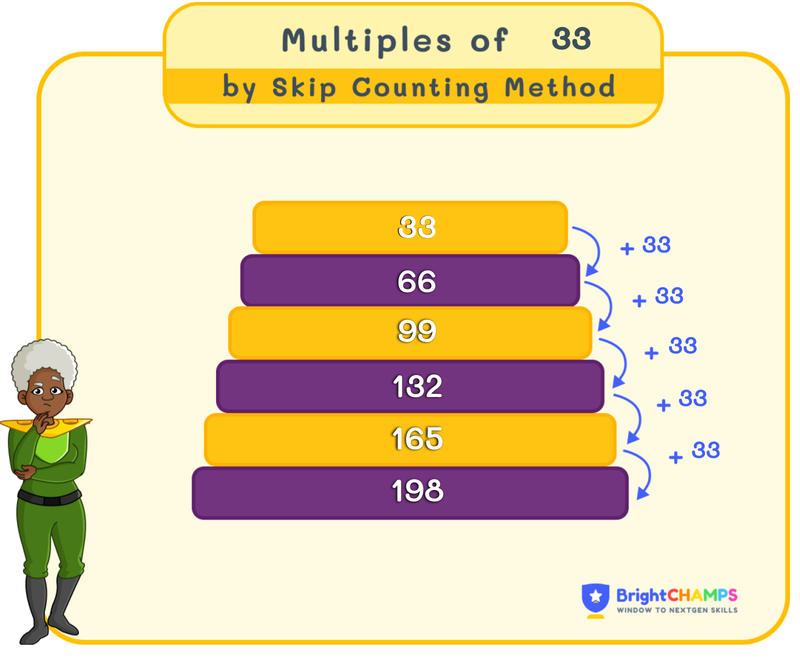


 123 Learners
123 LearnersLast updated on May 26th, 2025

Multiples of 33

In math, multiples are the products we get while multiplying a number with other numbers. Multiples play a key role in construction and design, counting groups of items, sharing resources equally, and managing time effectively. In this topic, we will learn the essential concepts of multiples of 33.
What are the Multiples of 33?
Now, let us learn more about multiples of 33. Multiples of 33 are the numbers you get when you multiply 33 by any whole number, including zero. Each number has an infinite number of multiples, including a multiple of itself. In multiplication, a multiple of 33 can be denoted as 33 × n, where ‘n’ represents any whole number (0, 1, 2, 3,…). So, we can summarize that:
Multiple of a number = Number × Any whole number
For example, multiplying 33 × 1 will give us 33 as the product. Multiples of 33 will be larger or equal to 33.
List of First 20 Multiples of 33
Multiples of 33 include the products of 33 and an integer. Multiples of 33 are divisible by 33 evenly. The first few multiples of 33 are given below:
| TABLE OF 33 (1-10) | |
|---|---|
|
33 x 1 = 33 |
33 x 6 = 198 |
|
33 x 2 = 66 |
33 x 7 = 231 |
|
33 x 3 = 99 |
33 x 8 = 264 |
|
33 x 4 = 132 |
33 x 9 = 297 |
|
33 x 5 = 165 |
33 x 10 = 330 |
| TABLE OF 33 (11-20) | |
|---|---|
|
33 x 11 = 363 |
33 x 16 = 528 |
|
33 x 12 = 396 |
33 x 17 = 561 |
|
33 x 13 = 429 |
33 x 18 = 594 |
|
33 x 14 = 462 |
33 x 19 = 627 |
|
33 x 15 = 495 |
33 x 20 = 660 |
Now, we know the first few multiples of 33. They are 0, 33, 66, 99, 132, 165, 198, 231, 264, 297, 330,...
Operations with Multiples of 33
Understanding the multiples of 33 helps solve mathematical problems and boost our multiplication and division skills. When working with Multiples of 33, we need to apply it to different mathematical operations such as addition, subtraction, multiplication, and division.
Sum of first 5 Multiples of 33:
33, 66, 99, 132, and 165 are the first five multiples of 33. When multiplying 33 from 1 to 5, we get these numbers as the products.
So, the sum of these multiples is:
33 + 66 + 99 + 132 + 165 = 495
When we add the first 5 multiples of 33, the answer will be 495.
Subtraction of first 5 Multiples of 33:
While we do subtraction, it improves our comprehension of how the value decreases when each multiple is subtracted from the previous one. 33, 66, 99, 132, and 165 are the first five multiples of 33. So, let us calculate it as given below:
33 - 66 = -33
-33 - 99 = -132
-132 - 132 = -264
-264 - 165 = -429
Hence, the result of subtracting the first 5 multiples of 33 is -429.
Average of first 5 Multiples of 33:
To calculate the average, we need to identify the sum of the first 5 multiples of 33, and then divide it by the count, i.e., 5. Because there are 5 multiples present in the calculation. Averaging helps us to understand the concepts of central tendencies and other values. We know the sum of the first 5 multiples of 33 is 495.
33 + 66 + 99 + 132 + 165 = 495
Next, divide the sum by 5:
495 ÷ 5 = 99
99 is the average of the first 5 multiples of 33.
Product of First 5 Multiples of 33:
The product of given numbers is the result of multiplying all of them together. Here, the first 5 multiples of 33 include: 33, 66, 99, 132, and 165. Now, the product of these numbers is:
33 × 66 × 99 × 132 × 165 = 23,241,369,600
The product of the first 5 multiples of 33 is 23,241,369,600.
Division of First 5 Multiples of 33:
While we perform division, we get to know how many times 33 can fit into each of the given multiples. 33, 66, 99, 132, and 165 are the first 5 multiples of 33.
33 ÷ 33 = 1
66 ÷ 33 = 2
99 ÷ 33 = 3
132 ÷ 33 = 4
165 ÷ 33 = 5
The results of dividing the first 5 multiples of 33 are: 1, 2, 3, 4, and 5.

Common Mistakes and How to Avoid Them in Multiples of 33
While working with Multiples of 33, we make common mistakes. Identifying these errors and understanding how to avoid them can be helpful. Below are some frequent mistakes and tips to avoid them:

Multiples of 33 Examples

Problem 1
Emily runs a small art studio and teaches painting classes. Each class consists of 33 students. If she conducts 5 classes in a week, how many students does she teach in a week?

165 students
Explanation
Each class has 33 students. To find the total number of students Emily teaches in a week, we multiply the number of students per class by the number of classes.
Students per class = 33
Number of classes = 5
33 × 5 = 165
Therefore, Emily teaches 165 students in a week.

Problem 2
In a community garden, a group of volunteers plants trees according to the first three multiples of 33. How many trees does each volunteer plant?

The first three multiples of 33 are 33, 66, and 99. The volunteers plant 33, 66, and 99 trees respectively.
Explanation
Identifying the first three multiples of 33:
33 × 1 = 33
33 × 2 = 66
33 × 3 = 99
Thus, the volunteers plant 33, 66, and 99 trees respectively.

Problem 3
A factory produces toy cars in batches. Each batch contains 33 toy cars. If the factory produces 12 batches in a day, how many toy cars are produced daily?

396 toy cars
Explanation
To find the total number of toy cars produced in a day, multiply the number of toy cars per batch by the number of batches.
Toy cars per batch = 33
Number of batches = 12
33 × 12 = 396
Thus, the factory produces 396 toy cars daily.

Problem 4
Liam is organizing a charity event and needs to set up chairs in rows. Each row has 33 chairs. If there are 7 rows, how many chairs are set up in total?

231 chairs
Explanation
To find the total number of chairs, multiply the number of chairs per row by the number of rows.
Number of chairs per row = 33
Number of rows = 7
33 × 7 = 231
Therefore, 231 chairs are set up in total.

Problem 5
Sophia is decorating a large hall for a wedding. She uses 33 balloons for each decoration cluster. If she makes 10 clusters, how many balloons does she use?

330 balloons
Explanation
To calculate the total number of balloons used, multiply the number of balloons per cluster by the number of clusters.
Balloons per cluster = 33
Number of clusters = 10
33 × 10 = 330
Hence, Sophia uses 330 balloons in total.


FAQs on Multiples of 33
1.How do you find the multiples of 33?
2.What are the real-life applications of Multiples of 33?
3.Are multiples of 33 finite or infinite?
4.Is there any odd multiples of 33?
Important Glossaries for Multiples of 33
- Multiple: A multiple represents the product of a number that may be multiplied by an integer. For example, multiples of 33 include 33, 66, 99, 132, etc.
- Number pattern: This refers to how numbers are listed. It should follow a certain sequence. Multiples of 33 are the numbers that consist of the number pattern of 33.
- Odd number: An odd number refers to any number that cannot be evenly divided by 2. All multiples of 33 that result from multiplying by an odd number are odd numbers.
- Divisor: It refers to any number by which another number can be divided without leaving any remainder. 1, 3, 11, and 33 are the divisors of 33.
- Product: The result of multiplying two or more numbers together. For example, 33 × 2 = 66 is the product of multiplying 33 and 2.
Explore More multiplication-tables
 Previous to Multiples of 33
Previous to Multiples of 33


Seyed Ali Fathima S
About the Author
Seyed Ali Fathima S a math expert with nearly 5 years of experience as a math teacher. From an engineer to a math teacher, shows her passion for math and teaching. She is a calculator queen, who loves tables and she turns tables to puzzles and songs.

Fun Fact
: She has songs for each table which helps her to remember the tables



